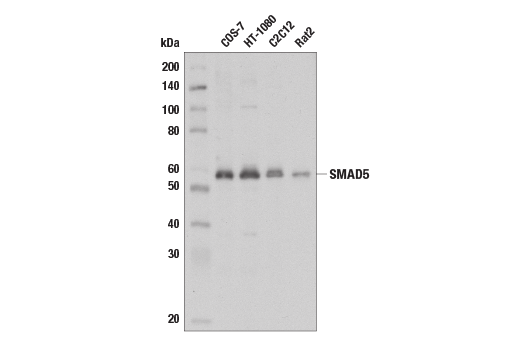
产品介绍
产品信息
分子量
60

背景
背景
Bone morphogenetic proteins (BMPs) constitute a large family of signaling molecules that regulate a wide range of critical processes including morphogenesis, cell-fate determination, proliferation, differentiation, and apoptosis (1,2). BMP receptors are members of the TGF-β superfamily of Ser/Thr kinase receptors. Ligand binding induces multimerization, autophosphorylation, and activation of these receptors (3-5). They subsequently phosphorylate SMAD1 at Ser463 and Ser465 in the carboxy-terminal motif SSXS, as well as SMAD5 and SMAD9 (SMAD8) at their corresponding sites. These phosphorylated SMADs dimerize with the coactivating SMAD4 and translocate to the nucleus, where they regulate the transcription of target genes (5). MAP kinases and CDKs 8 and 9 are also reported to phosphorylate residues in the linker region of SMAD1, including Ser206. Phosphorylation of SMAD1 at Ser206 recruits Smurf1 to the linker region and leads to the degradation of SMAD1 (6). Phosphorylation at this site also promotes SMAD1 transcriptional activity by recruiting YAP to the linker region (7).
1.Hogan, B.L. (1996) Genes Dev 10, 1580-94.
2.Hoodless, P.A. et al. (1996) Cell 85, 489-500.
3.Klemm, J.D. et al. (1998) Annu Rev Immunol 16, 569-92.
4.Kretzschmar, M. et al. (1997) Genes Dev 11, 984-95.
5.Whitman, M. (1998) Genes Dev 12, 2445-62.
6.Sapkota, G. et al. (2007) Mol Cell 25, 441-54.
7.Alarcón, C. et al. (2009) Cell 139, 757-69.

研究领域
癌症,发育生物学与干细胞研究,纤维化,神经科学,
声明 :本官网所有报价均为常温或者蓝冰运输价格,如有产品需要干冰运输,需另外加收干冰运输费。








 用小程序,查商品更便捷
用小程序,查商品更便捷







 危险品化学品经营许可证(不带存储) 许可证编号:沪(杨)应急管危经许[2022]202944(QY)
危险品化学品经营许可证(不带存储) 许可证编号:沪(杨)应急管危经许[2022]202944(QY)  营业执照(三证合一)
营业执照(三证合一)